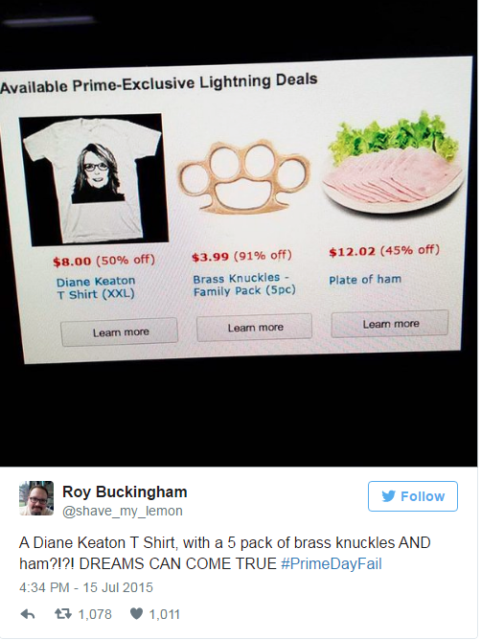Last year, Amazon launched Amazon Prime Day, a one-day sales event for Amazon Prime members. This year, on July 12, Amazon is bringing back this summer savings event.
As measured by sales volume, last year’s event was a success. But as measured by public perception, it was a pretty major fail with many customers seriously turned off by the bargain basement approach, kitschy clearance items, easy-come-easy-go deals, slow site performance (that led to missed deals), and heavy emphasis on Amazon products. The result? The unfortunate #PrimeDayFail hashtag which spread like wildfire across social media — at the expense of the Amazon brand.

For Prime Day 2016, Amazon is promising increased deals (as many as 100,000 sales items) and easier navigation to uncover the best discounts.
This is certainly a start, but, as a huge fan of Amazon, I think they can do even better.
So how can Amazon improve the Prime Day experience?
Customized offers. Amazon collects a whole lot of information about their Amazon Prime customers. For example, Amazon knows the first item I purchased from them — a short story collection by John Updike — and every other item since. That is the kind of customer insight that all retailers covet. When you create an Amazon account, you’re given a subscriber ID to track purchases and preferences. But this ID is for more than just tracking. Amazon uses it to create an intuitive subscription experience. Customers keep coming back to Amazon for this customized user experience, because they can easily find what they’re looking for (or things they didn’t even know they were looking for, but that they’d like to have) and make purchases with one simple click.
On Prime Day, Amazon should leverage this insight to deliver personalized offers that have been tailored to individual’s preferences. Don’t offer everyone a Diane Keaton t-shirt, brass knuckles, and a plate of ham. Clearly these items don’t have mass appeal. But maybe that member who recently purchased Annie Hall on Blu-Ray would love to have Diane Keaton plastered across his chest (though I’m still not sure who the target market is for that plate of ham…).
Transparency. Amazon has earned customer loyalty through its transparency: you know just what you’re getting when you go to make a purchase on Amazon. But on Prime Day, this transparency was lost. This year, Amazon should go back to their roots and let customers know how Prime Day is going to go down and what to expect. Deals shouldn’t be hidden, or buried. Limited offers should be called out as such. Pricing should be clear.
Systems in place. Oh the irony. Amazon Web Services (AWS) is a cloud service platform that provides the backbone for so many businesses. According to their own site, “millions of customers are currently leveraging AWS cloud products and solutions to build sophisticated applications with increased flexibility, scalability, and reliability.” And yet, on Prime Day, their own system failed: they couldn’t handle (and didn’t seem at all prepared for) their increased web traffic. This year, Amazon presumably has a better idea of what to expect come Prime Day. Hopefully they will use this insight to better prepare for the intense influx of site visitors – and to showcase AWS so as to continue to grow that arm of their business as well.
Celebrate their Prime members. Ultimately Prime Day is more than just a one-day sale. Amazon should use this day to reinforce and celebrate their ongoing relationship with their subscribers. This isn’t just a day for discounts – it’s a day to show their customers that they are known and appreciated. Make it about the customers, not just about the deals.
Arguably Amazon is the poster child for exceptional customer experience. On Prime Day 2016, if they can keep their focus on the customer experience and on their strong relationships with their customers, I have no doubt they’ll kill it in terms of sales and brand perception. Personally, I’m looking forward to seeing what deals Amazon has for me on July 12th and I can’t wait to see everyone else’s #PrimeDayWin.
Want to learn more about optimizing the subscription model and making your subscribers happy? Check out our free foundational guide to Relationship Business Management which includes the 4 gaps of ERP, the 3 most important RBM metrics, and more.